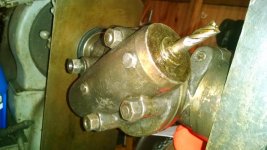kd1yt
Cast Iron
- Joined
- Dec 6, 2013
- Location
- Vermont, USA
I have a cone-pulley driven Brown & Sharpe #2 horizontal milling machine that is fitted with an interesting vertical/angle milling head. Like the rest of the machine, this part is covered with historic crusty goo.
I can see that the bit that is mounted in this vertical/angle unit is mounted in a collet, and would like to see how that comes apart- I see an allen head bolt protruding through a flat-hex on the top of this vertical adapter. My hunch is that loosening the allen bolt will loosen a drawbar-like pull on the collet- and when I loosen the allen-head, it backs up and out of the surface that it threads through. Light tapping on the head of the allen-head does nothing so far, and I don't want to whack it more firmly until I can confirm (if someone please can?) that whacking it will loosen the collet and not damage other things.
Also, any sense of what collet this likely takes? There was a steel box with some grubby collets marked "Rivett 7" sitting on the side shelf of the machine when the machine was given to me. Any chance that these would fit the B&S (from google, it appears that Rivett 7 is also "4s")?
Is this vertical/angle-able unit on the B&S horizontal mill anything unusually uncommon or especially useful? (forgive the newb questions, I am learning all of this from a total beginner status as I rehab and learn how to use these machines that I was given)
Thanks in advance



I can see that the bit that is mounted in this vertical/angle unit is mounted in a collet, and would like to see how that comes apart- I see an allen head bolt protruding through a flat-hex on the top of this vertical adapter. My hunch is that loosening the allen bolt will loosen a drawbar-like pull on the collet- and when I loosen the allen-head, it backs up and out of the surface that it threads through. Light tapping on the head of the allen-head does nothing so far, and I don't want to whack it more firmly until I can confirm (if someone please can?) that whacking it will loosen the collet and not damage other things.
Also, any sense of what collet this likely takes? There was a steel box with some grubby collets marked "Rivett 7" sitting on the side shelf of the machine when the machine was given to me. Any chance that these would fit the B&S (from google, it appears that Rivett 7 is also "4s")?
Is this vertical/angle-able unit on the B&S horizontal mill anything unusually uncommon or especially useful? (forgive the newb questions, I am learning all of this from a total beginner status as I rehab and learn how to use these machines that I was given)
Thanks in advance








